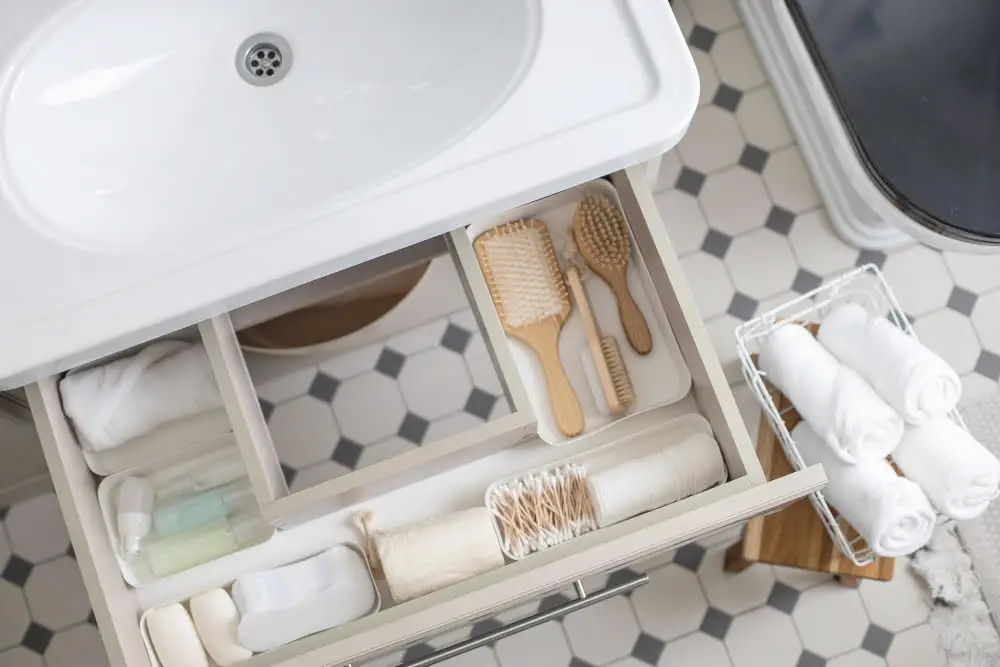Last updated on
Harnessing motivation to declutter can significantly transform your living space into a serene and orderly environment, promoting productivity and well-being.
Feeling overwhelmed by clutter is a common problem, but the good news is that motivation to declutter can be sparked in various ways.
This article will offer practical tips and strategies that will not only inspire you to start decluttering but also help you maintain a clutter-free environment in the long run.
With a combination of psychological insights, actionable steps, and proven techniques, you’ll be well on your way to a more organized, serene, and efficient living or working space.
So, if you’re ready to transform your cluttered space into a haven of order and tranquility, read on for a detailed guide on how to find and maintain your decluttering motivation.
Table of Contents
Understanding Decluttering

Decluttering is the process of systematically eliminating unnecessary items from your surroundings to create an organized and functional space. It extends beyond merely discarding unused stuff; it involves implementing effective storage solutions, creating a clutter-free layout, and cultivating habits of regular maintenance.
It’s not a one-time task, but an ongoing commitment to living with less and deriving value from what remains. By redefining your relationship with material items, you foster an environment that supports well-being and productivity while alleviating stress and distractions.
The Psychology of Clutter

Clutter is not just physical; it has psychological implications as well. It can incite feelings of stress, anxiety, and guilt, all of which can negatively impact mental well-being. In fact, studies show a direct correlation between the amount of physical clutter in one’s living space and reduced cognitive function due to increased distractions.
Psychologists also suggest that clutter can be a physical manifestation of an individual’s mental state. For example, it signifies difficulty letting go of the past or constant worry about the future. By clearing out unneeded items, it’s possible to find relief from these psychological patterns, creating both external and internal space.
The process of decluttering can therefore act as a form of self-care, helping to improve focus, productivity, and overall mental health. It’s not just about making your environment visually pleasant, it’s a deeply transformative act that can stimulate positive psychological change.
Understanding Your Decluttering Motivation

Recognizing your reasons for wanting to declutter can immensely boost and sustain your drive throughout the process.
Delve deeper and identify why a clutter-free environment is essential for you.
Is it to lessen the time spent on cleaning? Would you like a more restful and productive atmosphere at home? Or perhaps you plan on downsizing to a smaller space?
The motives will differ for each person and there is no one-size-fits-all.
Embarking on this self-reflection journey can help tailor the decluttering process to your unique needs and preferences, yielding more effective and lasting results.
Moreover, by rooting actions in personal motivations, you have a sturdy foundation to fall back on during challenging moments, making it easier to push through and continue the process.
Knowing Your ‘Why’ in Decluttering

The first step to maintaining decluttering motivation is identifying the specific benefits you hope to achieve. By having a clear understanding of your personal goals and needs, the process becomes much more tailored and impactful. It could be that you want to start a home office, need more space for your growing family, or seek to reduce the time spent cleaning.
The reasons are boundless and deeply personal. This insight forms the foundation for your decluttering journey, and it’s this foundation that will keep you motivated when the process becomes challenging.
When in doubt, remember your ‘why’. It’s the rudder that keeps your decluttering journey on course.
Why Decluttering Matters

The significance of decluttering extends far beyond a tidy environment and impacts several aspects of human lives.
First, it bolsters stress reduction by eliminating the chaos that disorganized piles of items can precipitate, thereby fostering a sense of tranquility.
Second, decluttering creates more space and fosters an environment conducive to creativity and productivity by eliminating distracting elements.
Lastly, decluttering aids in simplifying life. By possessing less, one’s clean-up time is diminished, and energy can be directed towards more fulfilling and crucial tasks.
In essence, beyond the physical dimensions, decluttering carries pervasive psychological and lifestyle benefits, accentuating its importance.
Powerful Reasons to Declutter

The transformative power of decluttering extends beyond aesthetic improvements.
First, a clean environment lessens distractions, enhancing focus and productivity.
An orderly home or workspace facilitates smoother routines, saving you time otherwise wasted on searching for misplaced items.
Second, decluttering is also linked to overall well-being.
Studies show a correlation between a cluttered space and heightened stress levels.
By promoting a sense of tranquility, a decluttered environment contributes to improved mental health.
Lastly, decluttering can be economically beneficial.
Separating the necessary from the superfluous may reveal items for potential resale or donation, and prevents unnecessary purchasing by reminding you of what you already possess.
Objective Benefits of Decluttering

Decluttering goes beyond creating a tidy space. It creates a ripple effect of several physical and mental benefits.
Firstly, a decluttered space is easier to clean, reducing allergens and improving overall household hygiene. It also enhances safety, as a clutter-free environment minimizes the risk of accidents, like tripping over items.
When you declutter, you’re also likely to find items you’ve forgotten about or thought were lost. This can save you money, as you’re less likely to duplicate purchases. Additionally, decluttering often leads to better management of your belongings which can save time in the long run as it’ll be easier to find and access what you need.
From a mental standpoint, decluttering can reduce anxiety and stress by creating a sense of order and space. This mental clarity often improves focus and productivity. Moreover, the act of decluttering can provide a sense of accomplishment, boosting self-esteem and overall happiness.
Lastly, when you let go of items, you’re also creating an opportunity to support your community by donating useful items to those in need. This aspect of giving can elevate your mood and contribute to a greater sense of purpose in life.
The Impact of Decluttering On Lifestyle

Trimming down your possessions can have a profound effect on your daily routine and overall quality of life. A decluttered space promotes less stress and more freedom. With fewer items, cleaning becomes less cumbersome and more manageable, saving you significant time and effort.
The surrounding free space can also lead to a better state of mind, allowing creativity to flow, decision-making skills to improve and enhancing focus.
Moreover, a decluttered environment can foster healthier behaviors. For instance, a clean and organized kitchen can inspire better eating habits, while a decluttered bedroom can lead to improved sleep quality. Decluttering can thus act as a catalyst for positive change, paving the way for healthier lifestyle habits.
Decluttering and Mental Health

In the realm of mental health, decluttering plays a significant role. A cluttered environment is often a source of stress, anxiety, and distraction, impacting focus and hindering productivity.
When the avalanche of stuff becomes unmanageable, it can evoke feelings of guilt and embarrassment, further escalating stress levels.
Studies have even linked extreme clutter with depression, anxiety, and Attention Deficit Hyperactivity Disorder (ADHD). Conversely, maintaining a clean and organized environment lessen distractions, mitigate stress, and invite calming effects, ultimately improving mental health.
Moreover, as a conscious activity, decluttering rouses mindfulness—one’s awareness and focus on the present moment—and induces a state of flow—an immersive state where one loses track of time and surroundings—a combination that in itself promotes inner peace and contentment.
The effects stretch beyond just a cleaner living space; it’s a mood-lifter, a confidence booster, and a discipline builder, making decluttering a significant tool for better mental health.
Hence, it’s not just about organizing physical space, but creating an environment conducive to mental well-being.
Obstacles to Decluttering

While every decluttering journey is unique, certain roadblocks frequently appear in the process.
One of the main hurdles is the sentimental value tied to items.
Emotional attachments can make it hard to part with certain objects, making the decluttering process a mental challenge.
Also, decision fatigue often sets in when there are too many objects to go through, making it easier to procrastinate.
Furthermore, a lack of time or lack of visible progress can be discouraging.
Deep-seated habits that lead to disorganization also present a significant challenge.
Recognizing these obstacles is the first step to overcoming them.
Overcoming Decluttering Obstacles

Embarking on a decluttering journey can be daunting due to several obstacles that may crop up along the way. But don’t fret; here’s how you can tackle them head-on.
Firstly, overcome procrastination by setting time-specific goals. Instead of looking at the whole house, focus on one room or even one drawer and set a timer for 15-30 minutes.
When you come across items of sentimental value that take up much-needed space, craft a plan for them. You can digitize old photos and records, turn old t-shirts into a quilt, or allocate a specific ‘memory box’ for smaller items.
For those items that “might be useful one day,” ask yourself if it has been used in the last year. If it hasn’t, it’s likely you don’t need it.
Lastly, set aside a few minutes daily for decluttering, integrating it into your routine. This can help prevent the accumulation of clutter and make the task less overwhelming.
Remember, it’s okay to ask for help. You can rope in a family member, friend, or even hire a professional organizer. Together, overcoming obstacles and sustaining the decluttering momentum becomes much easier.
Navigating Emotional Attachments

It’s natural to form sentimental bonds with items, especially those associated with fond memories or gifted by special people. Yet, these emotionally-charged items often contribute significantly to clutter.
To navigate these attachments, start by acknowledging your feelings. Strive to distinguish between the memory and the physical object. Remember, letting go of an item doesn’t erase the memory or the sentiment attached to it.
You may consider taking a photograph of the item, thus preserving the memory in a less space-consuming way.
Donate items that are still in good condition. Knowing that someone else will benefit from them can make parting easier.
Lastly, remind yourself of your decluttering goals. Is the emotional value of the item worth the space it occupies and the clutter it contributes to? By thoughtfully evaluating your emotional attachments, you can make decluttering decisions that honor both your feelings and your need for an uncluttered space.
Dealing With Sentimental Clutter

For items with sentimental value, the discarding process can be complex due to the emotions associated. The first step is acknowledgment – recognize the nostalgia linked to each piece. However, it’s crucial to remind oneself that memories are not in the objects themselves but in the mind.
To manage sentimental clutter, consider taking photographs of items before discarding, allowing preservation of memories without the associated physical clutter. An additional solution might be to repurpose or recycle items, giving them new life or utility.
Another technique is the ‘box method’. Allocate one box for sentimental items, filling it with the most cherished ones until it’s full. Any overflow indicates a need for further decluttering.
Lastly, establish a tradition of sharing. Pass down items to family members who will treasure them, sell items to those who appreciate their value, or donate items to enrich other people’s lives. By doing so, you’re giving a second life to your belongings, making parting easier.
Decluttering sentimental items might be challenging, but these tactics ensure memories are preserved while maintaining a clutter-free space. It’s an integral part of the decluttering journey, bringing you closer to the tranquil and organized environment you’re aspiring towards.
Choosing the Right Decluttering Project

To embark on the decluttering journey, start by picking a manageable task that is less likely to be overwhelming. A small drawer, a closet, or even a single kitchen cabinet will do.
Keep the scope narrow and set practical, attainable goals in terms of what areas to address and how much time to dedicate.
By choosing a smaller, less overwhelming project, you’re more likely to complete it and feel motivated to tackle larger ones as you gain confidence.
With time, you can move from smaller challenges to significant projects like an entire room or storage area.
Remember, the goal is not to go from cluttered to perfect in an instant but to gradually change your environment and habits.
Take into account factors such as the size of the area, sentimental value of items, and potential usage.
If you find decluttering a highly emotional task due to sentimental attachments, consider starting with less personal items like kitchen utensils or bathroom supplies.
Furthermore, adopting a “one-touch rule” will reduce indecisiveness – pick up each object only once and make an immediate decision about its fate: keep, discard, or donate.
Remember to celebrate small victories. Every bit of progress is a step toward a cleaner, simpler, and more serene space.
Over time, these successes will fuel your motivation to declutter. So, pick that first project wisely, and start the transformation.
Creating a Decluttering Plan

To start, identify the areas in your home or workspace that need immediate attention. Start small to avoid overwhelming tasks and boost your confidence with quick wins. A drawer, a shelf, or a corner of a room, for example, can be excellent starting points.
Once you know where to start, schedule decluttering time. Aim for consistent, manageable sessions rather than lengthy, infrequent ones — consistency is key to maintaining momentum.
Next is determining a system to triage your items. A popular method is the four-box technique, which involves sorting items into four categories: keep, donate/sell, trash, or relocate. This systematic approach can keep you focused and make the process more manageable.
Ensure you dispose of or find new homes for items you’re not keeping as soon as possible to prevent re-cluttering.
Finally, set specific, achievable goals to measure your progress and boost your morale. An organized space is not created overnight, celebrate small milestones along the way.
Setting Time-Specific Goals for Decluttering

To make your decluttering journey manageable, setting specific, time-bound goals is paramount. Choose a starting point, such as a room or distinct area, and allocate a reasonable time frame for its completion.
For instance, you could decide to declutter one room per week or one drawer per day based on your schedule and amount of clutter.
Using a timer can be helpful in avoiding feeling overwhelmed. You could apply the popular ‘Pomodoro Technique’, where you focus on the task for 25 minutes and then take a 5-minute break. This approach makes the process more manageable and less tiresome.
Remember that progress, not perfection, is the goal. Rome wasn’t built in a day, and neither will your clutter-free home. Consistent small steps will lead to big results over time.
Celebrate each completed task, no matter how small, as this will boost your morale and motivate you to continue.
Effective Decluttering Techniques

Start with a systematic approach to avoid getting overwhelmed. Divide your space into zones and tackle one at a time, beginning with the most cluttered.
Next, consider the Four-Box Method – labeling boxes as ‘Keep’, ‘Donate’, ‘Trash’, and ‘Relocate’. This makes deciding the fate of each item easier.
When determining what to keep, ask yourself: do I use this regularly? Is it functional or does it evoke positive emotions? If the answer is doubtful, let it go.
Vertical storage systems and multi-functional furniture can maximize your space and keep items logically organized. Always return items to their designated spots immediately after use. It prevents the build-up of new clutter.
Finally, remember, decluttering isn’t a one-time event but a lifestyle. Regularly reviewing and decluttering your possessions can maintain the tidiness of your space.
Making Decluttering a Habit

Consistency is key for sustainable organizational change. Start small, selecting an item a day to discard or donate. Gradually, increase this number as you gain confidence and consistency.
Treat this task as part of your daily routine, similar to brushing your teeth or making your bed.
Next, strive to implement the ‘one in, one out’ rule. When you acquire something new, eliminate something old or unused from your space.
This balance helps to maintain a manageable number of belongings and significantly limit the accumulation of clutter.
Lastly, include decluttering in your cleaning routine. When vacuuming or dusting, take a moment to inspect items and surfaces for unnecessary clutter.
Incorporating these small, manageable habits into your daily life will keep your space organized and clutter-free.
Motivation Tips for Consistent Decluttering

To maintain consistent decluttering, the first and most impactful step is to set tangible, realistic goals. Be specific about what you want to achieve. It could be as simple as clearing out a single drawer or as comprehensive as decluttering an entire room.
Consider chunking tasks into manageable sizes and building a schedule to ensure you are consistently working towards these objectives. You can use digital planner apps or simple reminder tools to reinforce your schedule.
Moreover, create a reward system. Treat yourself to a favorite activity, food, or any non-clutter reward after reaching a certain milestone. Positive reinforcement helps breed consistency in behavior, making decluttering a more enjoyable process.
Finally, don’t forget to focus on maintaining the reduced clutter. This requires discipline and the regular revisiting of your decluttering goals. It is natural to accumulate items over time, but having systems in place to manage these will keep the clutter at bay. Regular reviews of your space can help you spot anything out of place and correct it before it becomes a larger issue.
Implanting such strategies can substantially increase the odds of maintaining a clutter-free environment. Regular decluttering sessions coupled with disciplined maintenance create a habit over time, making it easier to keep your spaces tidy and organized.
Celebrating Your Decluttering Achievements

When you’ve successfully met your decluttering goals, it’s important to give yourself a pat on the back. Recognizing hard work and progress is an essential part of maintaining long-term motivation.
Regardless of how minor a task seems, every effort counts. Rewarding yourself doesn’t necessarily mean buying new stuff – that would beat the whole purpose of decluttering. Instead, consider rewards like an uninterrupted hour with a good book, a relaxing bubble bath, or a favorite hobby.
This association of effort with positive emotions fuels the ongoing process of decluttering, providing you with the drive needed to retain an organized, serene environment. Likewise, you can share your progress with friends or family members to reinforce the sense of achievement.
Remember, the aim is to create a sustainable, clutter-free space, and the celebration of small victories contributes significantly to this journey.
FAQ
Why is decluttering so hard for me?
Decluttering can be challenging due to the continuous decision-making process involved, which can be eased by breaking down the task into manageable sections and focusing on each independently.
Why do I feel the urge to declutter?
The urge to declutter often arises as a response to feelings of stress and anxiety, as removing excess items from your environment can temporarily alleviate these uneasy feelings.
Why I don’t want to declutter?
The reluctance to declutter might be attributable to a scarcity mindset, where the perception of safety and security is connected to the abundance of possessions, generating concerns of not having enough when needed.
What are the psychological barriers that prevent us from decluttering?
Psychological barriers preventing us from decluttering include emotional attachment to items, fear of scarcity, perfectionism, procrastination, and the feeling of being overwhelmed.
How does the brain respond to decluttering activities?
Decluttering activities stimulate the brain, especially the reward center, by triggering pleasure responses, promoting a sense of achievement, and reducing stress levels.
What can trigger the desire to hold onto clutter?
Emotional attachments, fear of scarcity, and a sense of overwhelm can all trigger the desire to hold onto clutter.




